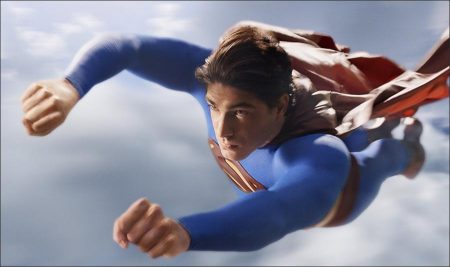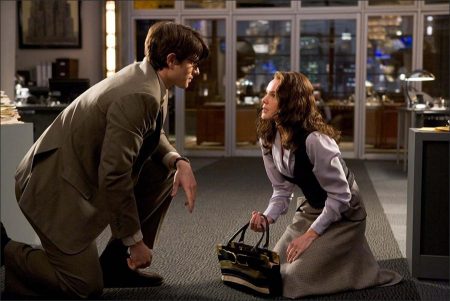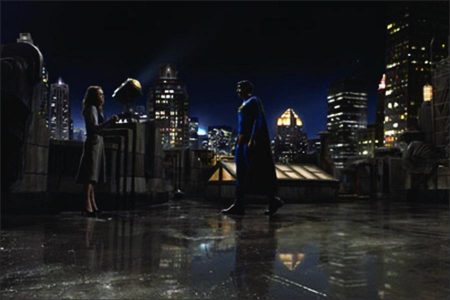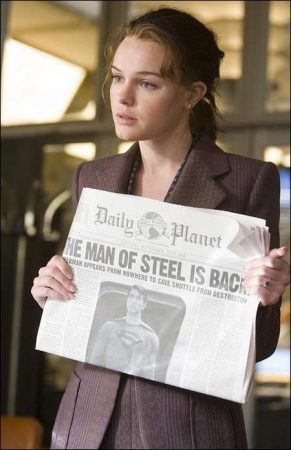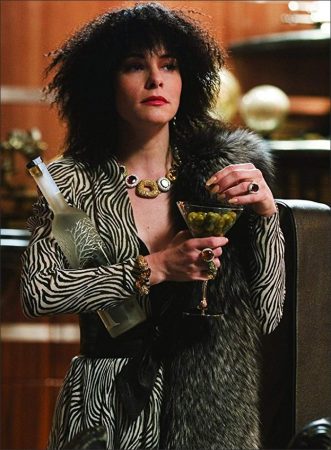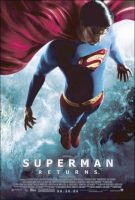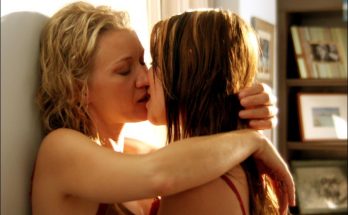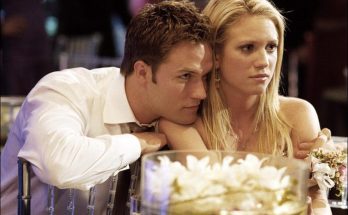Superman Returns Movie Trailer. “There’s not a country you can go to where they don’t know Superman,” says Superman Returns director Bryan Singer, who first gained widespread attention with the award-winning The Usual Suspects before going on to direct the acclaimed blockbusters X-Me and X2. “You could probably take the ‘S’ shield into the jungle and you’ll have fifty-fifty recognition. In that way he’s a global Super Hero.”
“Everyone has grown up with one version or another of Superman,” says Dan Harris, who wrote the screenplay with Michael Dougherty. “Whether we knew him from the comic books or the small screen or the big screen, we all know the Man of Steel. It’s as simple as that.”
“The combination of his virtue, his indestructibility and his ability to fly is what makes him so appealing to me and so many other people,” Singer says. “To do the right thing, to be able to take on anything that comes at you and to be able to soar up into the sky…we all have imagined at some point in our lives what it would be like to be him.”
Since making his comic book debut in 1938, Superman has remained an indelible figure in world culture and a universal symbol of humankind’s ideal. “He was the first to come from another planet and embody a lot of things that we, as human beings, dream about being able to do, primary among them being the ability to fly,” says executive producer Chris Lee. “But there’s also his super-strength, his ability to see through anything, and his sense of goodness. That lack of ambiguity is very appealing, and it has stayed the course throughout the 70 years of Superman’s history.”
The character went on to be featured in a newspaper strip which ran for more than three decades and today continues to entertain millions of fans each month in DC Comics comic books distributed worldwide through 25 languages in over 40 countries. On the big screen, the Man of Steel first appeared in 1941 in 17 groundbreaking animated shorts produced by the famous Fleischer Studios, along with two live action serials. Since then, the character has starred in five feature films, numerous successful series for television and 35 titles on video and DVD. The first-ever feature film was 1951’s Superman and the Mole-Men, starring George Reeves, which kicked off the subsequent television series.
The first contemporary feature film, Richard Donner’s Superman: The Movie, starring the late actor Christopher Reeve as the Man of Steel and film legend Marlon Brando as his father, Jor-El, was released in 1978. Director Bryan Singer first saw the film with his mother at a rural New Jersey theater on opening weekend. “I loved it,” he remembers. “It brought the character to such amazing life and yet it had a very nostalgic quality but at the same time was very contemporary. It mixed eras effortlessly.”
In times of rapid change – whether cultural, industrial or technological – Superman has steadfastly stood for truth, justice and all that is good. “The world in 1941 was much different than the world of 1978, which is much different than the world today,” says Singer.
“I think the Superman legacy is less about change than it is about evolution. Sure, he has battled different villains and there have been countless permutations of his costume over the years. Certainly in this movie he’s dealing with an incredible amount of change after being gone for five years. Yet one thing remains constant…his inherent trait to use his special abilities to lead by example and to do good for the world.”
He has served generations as both a reminder of the potential for greatness within humankind, and a powerful savior everyone could believe in. In Donner’s Superman: The Movie, Brando’s Jor-El posthumously tells his son whom he has sent to live amongst humans on Earth that human beings are capable of greatness; they only lack the light to show the way.
Bryan Singer’s Superman Returns is the spiritual descendent of Superman: The Movie and Superman II and utilizes elements of Marlon Brando’s performance as Jor-El. “I think the choice to do a kind of sequel to Donner’s film has given us flexibility and confidence to move things forward,” says screenwriter Michael Dougherty. “We felt that everyone, whether they realize it or not, knows the origin story. Everyone knows who Superman is to different degrees. We are simply trying to continue that story.”
Singer has always felt an emotional affinity for the character and had a precise vision of where he wanted to take the Super Hero in this film. “Superman and I share the fact that we were both adopted,” he says. “I was an only child and he was an only child. For those very basic reasons, I have always felt a real connection to him and that is why he is my favorite Super Hero. That is why it was so important for me to tell my Superman story my way.”
Producer Jon Peters recalls first hearing the story Singer wanted to tell. “I remember getting goose bumps and feeling ‘Wow…that is right on the money,’” he says. “The story is contemporary, emotional, action-packed and a love story, too. It hits all the bases that we want in a Superman movie.”
“Bryan is a terrific filmmaker,” says producer Gilbert Adler. “His great success in the past stems from the fact that he’s a natural born storyteller. Bryan tells a riveting story, whether it’s at the craft services table or up there on the big screen. Bryan is a maestro!”
From a child wearing a cape and Superman pajamas to the dedicated comic book collector to the moviegoer waiting two decades to once again believe a man can fly, the time of Superman has come again.
“Society – the world – has changed so drastically in the last thirty years or so since Richard Donner’s film,” says Superman Returns cast member Frank Langella. “I think Superman returning now is a great thing. He’s coming back at a time when people have a real need, I think, to sit there for a couple of hours with a big box of popcorn and a soda and have someone sweep them off their feet again.”
The Story and the Players
Since mysteriously disappearing from Earth five years before, Superman has traveled to the far reaches of space in search of his past and traces of his family, or others like himself. But, finding a radioactive ruin where Krypton once stood, the man who was born Kal-El returns home, crash-landing back at the Kent farm in Kansas.
According to Singer, Kal-El, whom the Kents named Clark, is very much a product of his upbringing. “People always ask, ‘which is the costume and which is the disguise?’” says the director. “But in reality both are identities he wears. There’s a bit of showmanship in being Superman, in the way you present yourself. And there’s definitely a character in Clark, a charade he’s putting on to make himself awkward and invisible. But the true Clark Kent is the man who was raised on the farm by Martha and Jonathan Kent. I never wanted to lose that. Even at points when he is awkward Clark, the foundation of Superman is how the character was raised on the farm.”
Singer needed an actor who could embody all the qualities of Kal-El, Clark Kent and Superman, who could handle the rigorous physical and emotional demands of the role, and who would be a worthy successor to the late Christopher Reeve. And yet from the beginning he was intent on casting an unknown actor. “However daunting that task may have been to fill the boots of Christopher Reeve, the actor to play Superman couldn’t have the baggage of being a movie star,” says Singer. “I needed someone who represented and looked like the collective memory we all have of Superman.”
Richard Donner, who initially cast Reeve, faced the same challenge nearly three decades ago. Whoever plays Superman, says Donner, has “got to bring to life the son of Jor-El. He’s got to bring reality and purity to this character. He’s got to then evolve into a Super Hero. If in any way he is tainted with past references, it would be a major mistake. I think Bryan faced the same conundrum. The moment you associate the actor with another role, you lose the character. To make a man fly and believe it, it had to be an unknown then, and I think today it’s even more true.”
Months of searching yielded a tape of an undiscovered actor who had auditioned for a previous Superman film in development at Warner Bros. Pictures. Twenty-six-year-old Brandon Routh had been one of those kids in Superman pajamas “flying” around his childhood home in Norwalk, Iowa. Even on his audition tape, Singer saw in Routh qualities that extend beyond his uncanny physical resemblance to Superman. “Just talking to him I got a sense of his mid-western upbringing and all the classic ideals that come from that sort of childhood, which are the same kinds of ideals that Superman embodies,” Singer says. “Then, of course, there is his physical presence. He looks like he walked off a page in the comic book. Pretty much at that point, he became my first and only choice because I felt confident he could handle all three roles – Kal-El, Clark Kent and Superman.”
Though not formally told he had the part, Routh immediately began getting calls for costume tests and physical training. It wasn’t until he found himself in Australia, on the Kent Farm set, that the experience became real. “Walking up to Clark’s room, Kal-El’s room, it was exactly as you would imagine it would be,” Routh says. “My first shot as Clark was walking across the farm yard and I felt it then too. It’s such an all-encompassing experience, playing this character. It’s a big responsibility to be true to Bryan’s vision, and to embody someone that so many people around the world have seen in their minds.”
The director’s faith in Routh gave him the confidence to reach deeply into his own character to play the role his way. “Bryan’s passion and enthusiasm for this story was infectious,” says Routh.
The first time Routh wore the costume in front of an audience was shooting a scene in the Daily Planet. “If you’re only human, how do you imagine that you’re superhuman?” he says. “How do you play that grandness and goodness? I wanted to be true to everything that has come before, but I also needed to embody the character in a way that would help the crew believe in the character and feel excited about being a part of this film.”
Routh’s first scene as Superman had a galvanizing effect on everyone present. “There’s a great heart at the base of this actor and this person,” says producer Gilbert Adler. “That’s what we all responded to in Brandon. He has a great heart. He has a great understanding of human nature, and I think that’s what makes his portrayal of Superman so compelling. He always had Clark down and it took him no time to become Superman.” “Clark comes naturally to him because he is Clark,” says screenwriter Dougherty. “He’s this guy from Iowa who is 6’3” and good looking, but shy and kind of awkward at times.”
Unlike the casting of Superman, finding a man to play his diabolically brilliant nemesis took no time at all. Singer directed Kevin Spacey to his first Academy Award (for Best Supporting Actor) for his performance as Verbal Kint in The Usual Suspects. “We wrote the character with Kevin in mind,” says Singer. “Ever since The Usual Suspects we had been looking for something to do together and he is extremely perfect for the role. He has just the right blend of humor and cynicism and, of course, he is a brilliant actor.”
The most challenging aspect of casting Spacey was finding a break in his intensive schedule on the London stage. “With all of his work at the Old Vic in London, we were forced into a very confined amount of time for him to be in Australia,” says Singer. “I think we had just six weeks with him and we shot everything we needed to and got him back to London in time for his next project there.”
“It was a fantastic shoot and a lot of fun,” says Spacey. “Bryan and I had a wonderful experience making this movie and an extraordinary experience making The Usual Suspects. In a lot of ways it was like not a day had gone by and it was so enlightening to see how much he has advanced as a filmmaker in the last ten years.
The two-time Oscar winner (his second award, for Best Actor, was for his performance as Lester Burnham in Best Picture Oscar winner American Beauty) describes his Lex as “much darker, bitter and out for revenge but still with a comic flair. He is the ultimate capitalist. He’s got wide-ranging, hugely complicated evil plans. But at the end of the day, it’s really basic. He just wants his cut.”
Lex has spent the last five years in prison, but is released when Superman misses his parole hearing. For his emergence from prison he has arranged a means to a lifestyle in the form of heiress Gertrude Vanderworth (played by Noel Neill, the woman who originated the role of Lois Lane in the first two screen serials in the 1940s and reprised the role in the 1950s television series with George Reeves, replacing Phillis Coates. Gertrude, after whom he names his state-of-the-art yacht, will soon make Lex a very rich widower.
“Lex has gone through so many changes and feels that he has been so betrayed that he is now out for revenge,” Spacey describes. “He has been away for a while and Superman has been away for a while, and Lex has a remarkable plan for when they come back together that, of course, involves real estate. As a character, Lex Luthor has always been about property.”
After Kal-El’s ship crash lands back in Kansas, he finds many things about his world have changed. The world has moved on, as evidenced by the Daily Planet headline, “Why the World Doesn’t Need Superman,” penned by none other than Lois Lane. “There is nothing stronger or more devastating to Superman than to be told by the woman he loves that he’s no longer relevant in the world and this thing he thought he was destined to be is not really appropriate any more,” Harris says. “Lois has written that people need to move on and learn for themselves and not to rely on having a savior. This, of course, was her way of getting over him.”
“The world has forgotten about its savior,” says Chris Lee. “When he returns from his journey, he’s faced with the dilemma of trying to figure out his place in the world – now that he’s been gone for so long and Lois has so publicly proclaimed why the world doesn’t need him. And, as usual, mothers always have the best advice.”
Martha “Ma” Kent, Clark’s adoptive mother, is played by film legend Eva Marie Saint (North by Northwest, On the Waterfront). Martha is overjoyed to have her son back, but also sees clearly that his fate lies elsewhere. “Throughout his childhood, his parents told him that he had to do good things with the power that he had,” says Saint. “But he is discouraged when he comes back and needs her to boost him up enough to give him the confidence to go back and be Superman.”
Saint, who won an Oscar for her performance in On the Waterfront opposite Marlon Brando – Superman’s cinematic father, Jor-El – had the unique experience of playing a role that impressed her grandchildren. “I was very happy to do the movie because it’s wonderful to keep working; that’s what I do,” she says. “But when my three grandchildren found out, their first reaction was a collective ‘that is so cool.’ They told all their friends about it, too. Good for business. Right?”
Saint credits Singer for guiding her through an emotionally and physically charged scene in which Ma Kent discovers the burning wreckage of her adopted son’s spaceship. “That was a long night of filming,” recalls Saint, “but Bryan has such patience and good instincts and lets his actors explore and try different things. I think you really see the love between a mother and her only child. It seemed natural to be a loving mother to Brandon Routh, who is a dear young man and a gifted actor.” Saint adds, “My favorite dream is flying, and I secretly hoped that I could fly with Superman. However, it’s still a dream.”
Heading back to Metropolis, in his bespectacled Clark Kent persona, Clark soon comes to the uncomfortable realization that his old friend, rookie photographer Jimmy Olsen, is the only one who really noticed he was gone. “Jimmy thinks Clark has been hitchhiking around the world all this time,” says Sam Huntington, who plays the cub photographer. “So, he has this whole conversation with Clark about places where he thinks he’s been and Clark hasn’t been to any of them.”
Jimmy is also the first one to break the most devastating news of all to his old friend. Lois, the love of his life and human connection he most needed, is now engaged and has a son, Jason, played by newcomer Tristan Lake Leabu. “That’s an obstacle stronger than Kryptonite,” says Singer, “and one that’s harder to navigate through, and therein lies the emotional core.” “So, he is completely an outsider again,” adds Routh, “after he has come back to the one place where he thought maybe he wasn’t an outsider.”
To portray the embodiment of a character almost as universally known as Superman himself, Singer needed a young actress that could bring to bear both Lois’s trademark intelligence and wit and also the added layers of growth and hardening that has come with her years of waiting for Superman.
The answer came by way of Singer’s old friend and collaborator Kevin Spacey. In 2004, Spacey directed and starred in a biographical film about 1950s singer Bobby Darin that co-starred Kate Bosworth as Sandra Dee. “I was lucky enough to see an early screening of Kevin’s Beyond the Sea and I was just blown away by Kate’s portrayal of Sandra Dee,” Singer recalls. “Kevin had told me she was terrific to work with so I had her come in and read with Brandon. It was pretty clear that they had a real immediate emotional connection and we all thought she would make a wonderful Lois Lane.”
“What a privilege it was for me to do this film,” says Bosworth, who first shot to international attention as the spirited female surfer in Blue Crush. “I felt a huge responsibility and a great amount of pressure just because everyone in the world knows and loves these characters so much. In this film they have progressed and you really get to see their inner life, so it was therefore so much fun to play. I think the fans are going to enjoy Lois and Superman back together on the big screen.”
No sooner is he back than he learns that Lois is in peril – a shuttle is being launched from the back of a jet, with Lois among those on board. “They first see each other when the world sees for the first time that Superman has come back,” says Routh.
After a breathtaking rescue involving hundreds of tons of burning metal careening through space and nearly crash-landing in a baseball stadium, Lois and Superman set eyes on each other for the first time in five years. “Superman has landed the plane,” Routh describes, “and he steps in the door to make sure all the people are all right, and makes eye contact with Lois. That’s a pretty powerful moment between the two of them. It’s very short. They don’t say much at all to each other. But there is an unspoken connection between them. She doesn’t turn away from him. So, even though she has written this article about him, he knows there’s hope.”
He also forms a connection with Lois’s young son, who has never experienced the world with Superman in it. One person who doesn’t hide his joy at the return of Superman is Daily Planet editor Perry White, played by veteran actor Frank Langella (Dracula). “It doesn’t matter whether you’re seven or 70, when a hero comes back into your life it really runs up the back of your neck,” says Langella. “It’s a universal thrill when someone of this epic, iconic stature comes back into your life. What an extraordinary thing to have these kinds of heroes.” But, on a more practical scale, “Perry White is concerned about his paper and its circulation, so he’s very happy that Superman is back because it means that the paper will have Superman exclusives again and will therefore sell,” Langella adds. “Very happy indeed.”
Sam Huntington, this film’s Jimmy Olsen, is a lifelong Superman fan and got the added thrill of playing a scene opposite Jack Larson, who originated the Jimmy Olsen role in the ‘50s television series. “Jack is an icon to me, and it was an honor to play not only opposite him but as the character that he originated,” Huntington says. “He also tells the best stories about how his life was affected by portraying such a famous character. The whole experience for me as an actor and a Superman fan was a dream come true.”
In addition to all the more familiar characters, Superman Returns introduces two new personae to the Super Hero’s universe: Lex Luthor’s sidekick Kitty Kowalski, played by Parker Posey; and Richard White, Perry White’s nephew and Lois’s fiancée, played by actor James Marsden.
Kitty Kowalski, while not a “bad guy” herself, has certainly fallen in with a few and gets more than she bargained for when she becomes a key player in the plot to destroy Superman. “Kitty loves the lifestyle that Lex can offer her,” says Posey, the acclaimed star of such films as Personal Velocity, Best in Show and The House of Yes. “She also loves the humor and even the deviousness of Lex,” Posey continues. “But the whole experience definitely becomes more serious and grave than Kitty ever imagined, and she ends up clinging for her life to this little inherited dog.”
“Parker brings incredible dimensions to Kitty, who is spiritually related to the first and second film’s Miss Tessmacher,” says Singer. “And like Tessmacher, Parker’s Kitty is both fun and cheeky and a great foil for Lex, but Kitty also has somewhat of a conscience, which Lex definitely doesn’t have.”
Richard White, an assistant editor at the Daily Planet, is engaged to Lois and the man Lois’s young son Jason calls “Daddy.” “Richard White is a new character to the Superman universe,” says Marsden, who played the Super Hero Cyclops in Singer’s X-Men films and reprises the role in this year’s X-Men: The Last Stand. “It was interesting working with Bryan on a totally different kind of role. It was really cool to get to create the guy that may or may not come between Lois and Superman.”
“It’s not that Richard is a bad guy – he’s a great guy – but is he right for Lois?” asks Routh, before answering with a smile: “No, because Superman is.”
As Superman struggles to find a way to reconnect with Lois, “The other part of his journey,” Routh adds, “is learning to accept his responsibility, his destiny, to be Earth’s greatest protector.” In thrilling and exhilarating trips around the globe, he thwarts evil wherever he is needed. The world rejoices in the return of the Super Hero many had forgotten existed.
But his greatest test will come in the form of Lex Luthor’s latest and most diabolical plot against not only Superman but all of humankind, which will at once test his faith in humanity and his ability to overcome any obstacle his enemies throw in his path.
Australia and Metropolis
Principal photography began near Breeza, Australia, on a rural piece of farm land that had been transformed into a working back lot. Six miles of road constructed by the production company provided access to the “base camp,” which consisted of star and filmmaker trailers, catering and lunch tents, and trailers for every department on the film including hair/makeup, wardrobe, special effects and visual effects. Base camp was even equipped with an IT trailer capable of running an entirely wireless network internet connection smack in the middle of Australia’s bush country.
All roads on the property led to the Kent Farm, where production designer Guy Hendrix Dyas recreated the iconic Kansas home of Ma, Pa and Clark Kent. From the mailbox at the end of the drive to the swinging chair on the front porch of the humble farmhouse, Dyas and his teams of designers, artists, craftsmen and construction crews built Superman’s highly-detailed boyhood home. A 30-foot high barn painted in a classic oxblood red and five acres of six-foot tall corn are highlights of the farm’s design and functionality.
For three weeks, the Superman Returns filming crew relocated to New South Wales in order to shoot the breathtaking Kent Farm set which was built near the little country town of Tamworth. Recreating Superman’s childhood home was nothing short of amazing (new roads were created, telephone poles were installed for miles and crops were planted from seed).
For three weeks, the production commuted to the site from the town of Tamworth, where it booked up most of the hotel rooms, restaurants and pubs. It enabled the filmmakers, along with actors Brandon Routh, Eva Marie Saint, James Karen (who plays Ben Hubbard, who is courting Martha Kent) and Stephan Bender (who plays 15 Year Old Clark in a series of flashbacks) to immerse themselves in its Norman Rockwell, mid-America setting and experience everything from the blistering summer heat to some of the most beautiful sunsets they’d ever seen.
“Growing the corn out in Tamworth was a huge challenge,” says Dyas. “That particular region of Australia had been suffering through many years of drought. We actually had to create our own irrigation system just to keep our Kent Farm crops alive until the end of our shoot. It was quite an incredible achievement, and our corn fed many of the local farm animals when we finally packed up and left. It was very labor-intensive having to build so much in the middle of nowhere but I think that Bryan and I achieved what we had envisioned for Martha Kent’s farm and it certainly allowed some beautiful moments to be captured on film.” Dyas adds, “From day one to wrap, whenever Bryan and I talked about the look of the film we always referenced Superman’s existing universe whether it be in the comics, TV series or earlier films. This is something that Bryan holds very close to his heart so when designing each environment I was very mindful of Superman’s past incarnations.
Our goal was to update the Superman world, not to re-invent it. The Kent Farm was one of the first sets I had to design for this film and it was a wonderful starting point because I was able to instill a high level of classicism and romanticism from the very beginning.”
“No doubt that there is a romantic quality to the look of the movie just like there is within the story,” says Singer. “I think we successfully merged some of those iconic John Barry designs from the 1978 Donner film with the look of a 1940s romance, whether through the color palette or the visual compositions or the Art Deco facades and gleaming skyscrapers of Metropolis. It’s certainly not a period piece. It’s a blend of old and new which essentially gives it a real timeless feel. That was the approach we took with all the design elements.”
After completing the Kent Farm sequences, the production returned to Fox Studios Australia, which became the base of operations in Sydney. The production occupied all seven soundstages and kept to an around-the-clock set construction schedule. “As soon as filming would finish on one set, we’d strike it to immediately make room for our next build.”
At one point space got so tight that Dyas was forced to turn one of his construction warehouses into a stage in order to accommodate the interior set of the film’s 200-foot yacht, The Gertrude. “When you include all the airplane and yacht gimbals and water tanks and green screen elements, we probably ended up with close to 80 sets,” says producer Gilbert Adler.
“As challenging as that was, there were no other movies being shot on the lot so we were able to take it over and make it completely our own space. It gave us a great amount of flexibility and creativity in scheduling and construction which was paramount to having all the sets look and function fantastically.”
Like the Kent Farm, Singer knew there were other places in the universe that he wanted and needed to include in his return story, most notably, the interior, exterior and rooftop of the Daily Planet building as well as the fan-favorite Fortress of Solitude. “The Fortress of Solitude is a good example of how we used the basic design that John Barry created in the Donner Superman movie,” says Singer, “but were able to expand on that with the advancements in visual effects technology.”
Dyas took inspiration from the 1978 sets by John Barry and constructed a “crystal ship” for Superman which measured 150 feet wide by 135 feet deep, and was approximately three stories high. “This set was deliberately reminiscent of the crystal pod that carries Superman to earth in the first Richard Donner film,” says Dyas.
“However, it’s been incredibly updated and it brings to mind the science experiments many of us did as kids when we made crystals grow. Superman uses his own ‘Crystal technology’ to create the ship and I think the end result looks very unique and elegant– it glows internally and it’s beautiful yet unearthly. We used similar design principles to create Superman’s Fortress of Solitude and with the help of new technologies were able to push the crystal idea much further in its execution. For example, instead of seeing the Fortress of Solitude from only one direction as in the set of the 1978 film, we were able to create a 360 degree view enabling Bryan to pan the camera around this amazingly vast cathedral-like environment. It was quite spectacular.”
Dyas created a unique design for the Daily Planet building under the operating theory that, like many classic Art Deco buildings in New York, the Daily Planet building in Metropolis would have been renovated in some fashion over the years to keep up with the latest in news-gathering and publishing technologies. “I think Guy did a brilliant job in blending the Deco feeling of the exterior façade and interior lobby with the latest in plasma televisions and flat screen computer monitors in the bullpen,” Singer comments. “Here again, the old and the new combined to become timeless … just like Superman.”
The Daily Planet set took six months to design, four months to build and a month to properly light. “We had something like 3,000 lights and 19 miles of cable for that one set,” Adler recalls.
“Bryan likes sets to have layers upon layers of detail so with the Daily Planet I was able to let my imagination run wild,” says Dyas. “Early in pre-production, we did some research and visited the original Daily News building in New York which was designed in 1929 by Raymond Hood. That marvelous period of American Art Deco architecture was hugely influential on my designs, especially for the interior of the editorial office of the Daily Planet newspaper. And even though we wanted the film to be contemporary in style, I was inspired by the 1930s mode of geometric designs, glass and bold colors.” These influences can also be seen on the classically ornate exterior of the Daily Planet building and its bustling plaza.
Dyas adds, “We wanted to keep the iconic spinning globe at the top of the Daily Planet building along with its rooftop which sits high above Metropolis. This became a wonderful setting for one of the romantic scenes.”
The plaza set that Dyas needed to create for the film was so large that none of the Fox stages could accommodate it so, in an unconventional move, the filmmakers decided to build the set outdoors, using the road between two existing soundstages. “Believe it or not, building it outside worked really well,” notes Dyas. “The weather was fantastic and we were able to fill the nearby roads with yellow cabs, buses and other street traffic. We also transformed an adjacent area into a mini Central Park and added a subway station. It was definitely one of our most challenging sets to build, but it turned out beautifully.”
In addition to the Vanderworth yacht, Dyas created two other sets which were completely unique for Superman Returns. Dyas designed an intricate model train set to be built in the basement of the Vanderworth mansion along with an enormous island set that was simply referred to as New Krypton. “I think the only way to describe New Krypton is if you imagine a cross between the Arizona desert and the Arctic shelf,” says Dyas. “For its design, we used crystal-like shapes and formations which are a part of the visual mythology of Superman’s world. It’s reminiscent of Superman’s Fortress of Solitude but less luminous and far more devoid of color.”
“In contrast, the model train set was like a miniature playground and my crew had a wonderful time assembling hundreds of model kits to create hyper-realistic towns and landscapes,” says Dyas. “We were extremely meticulous when it came to details because when Lex destroys the train set with his crystal experiment it’s a metaphor for the destruction he intends to achieve on a human scale. Our train set was already enormous by regular standards but since it needed to look even bigger, we built a basement set around it using forced perspectives and other design tricks. For example, the basement’s concrete pillars were built farther apart near the front of the set and then much closer together as you got back. We also used three different scales of miniature trains, using the largest ones in the foreground near the camera and the smaller ones in the background,” explains Dyas.
“We needed hundreds and hundreds of kits to make such a large train set look realistic and we couldn’t have done it without the generous help of a German company called Märklin. Their trains and model kits are simply exquisite and over the course of several months they sent us countless boxes of treasures.” Included in the many vignettes of the train set are environments as diverse as a cacti-filled Arizona desert, a gleaming skyline of Metropolis and the snow-peaked mountains of the Swiss Alps.
The same blending of classic and cutting edge went into the film’s costume design. First and foremost on everyone’s mind from inception was the Superman costume itself. Singer wanted the suit to reflect not only the iconic image that has lived in culture over the ages, but also bring a contemporary edge to the character.
“I remember the first day Brandon came in,” says costume designer Louise Mingenbach, who is no stranger to Super Hero wardrobe having designed the costumes for both of Singer’s X-Men movies. “I remember him saying that it was really important to him that the costume be comfortable so as not to be distracting for him in any way. Of course, never meaning to be insensitive, I just laughed and said ‘Baby, you are never going to be as uncomfortable in your life as you will be in this costume. It is not easy being a Super Hero and being one is certainly not about comfort.’
“It was really kind of sweet, actually,” says Mingenbach, “because, at that point, Brandon really didn’t know what he was getting into.”
What he would practically live in for the next few months was a dyed-blue, skintight fabric called Milliskin under which a contoured “muscle suit” would be worn. “Because the Milliskin is so tight, it flattened Brandon’s natural musculature that he had been working very hard to develop so we, in turn, had to develop the muscle suit in order to give back some of his body’s natural shape and contours,” says Mingenbach.
The costume’s famous “S” shield is made of a molded latex relief that was then laser-cut with thousands of tiny “S” insignias. The cape’s lining was made of wool and specially milled in France. It was then given an ombre treatment which gives the center of the cape its vibrant red color. The outside of the cape was then “rubberized to give it some texture and weight,” says Mingenbach. “So you can see why there would be nothing comfortable about wearing two skin tight suits and a ten pound cape on top of it all.”
To inhabit the suit as Superman, Routh would need to undergo intensive physical training, which began practically before he knew he had the part. While in Los Angeles, Routh trained with Gudni Gunnarsson. “The few months of training in L.A. were basically about getting in shape to get in shape,” Routh says. “It was all about training my body to endure the stress of heavier lifting later on in Australia.”
Once in Sydney, Routh began working with Australian trainer Michael Ryan, who put the actor through near-superhuman rigors. “The workouts started out tough and always stayed tough,” Routh recalls. “Many times I felt more like an athlete than an actor,” he says.
“Hanging fifty feet in the air or holding my breath fifteen feet below water wearing a very constricting costume put tremendous stress on every part of my body, especially when we did those scenes all day long for many days in a row. As crazy as it sounds, I adjusted and my body got used to it.”
The average day was heavy weightlifting for an hour or more, running and then on to wardrobe fittings, hair and makeup tests and camera tests. “I learned a lot, I achieved a lot and I gained an incredible amount of confidence in myself thanks to the expertise of everybody around me.”
The Physics of Flight and the Genesis Camera
Since the 1970s, when Richard Donner made Superman: The Movie, technology has advanced to levels that were merely daydreams of filmmakers in that era. With these great advances in camera and visual effects technologies, Bryan Singer believes that “we all will believe again that a man truly can fly.”
Singer and his team sought to first and foremost create the physics of the character and his universe. “Brandon and I built up our own physical laws which became the directorial palette for the flying sequences,” says Singer. “For example, how much strain does it take to catch a plane in flight or when do you leap and when do you float? What kind of hand motions does Superman use to navigate himself during flight? Thanks to endless discussions between me, Brandon, all the stunt coordinators and flying teams and to technology itself, Brandon will fly like no other Superman ever could.
“The state-of-the-art technology we used in making this film didn’t even exist two years ago,” Singer says. “The progress made in the visual effects arena is just astounding. As opposed to a Super Hero like Spider-man, Superman’s hair and face are exposed therefore his performance and personality are exposed even in flight.”
The filmmakers paid meticulous attention to detail to the physical shooting of Routh as well as the computer rendering, scanning and animation of the character in order to capture the reality of a man who can fly at will.
Perhaps the single most cutting edge piece of equipment used in making the film is the digital Genesis camera, a joint invention by Sony and Panavision. Superman Returns is the first feature length motion picture to be shot entirely with the Genesis camera system.
“The idea of possibly being able to use the Genesis camera came about after I had cast Brandon in the role,” recalls Singer. “We did a screen test with the intended format of Super 35mm and, for the hell of it, we shot one on 70mm. When the film from both cameras was processed, we watched the 35mm first and then clicked projectors to the 70mm. The clarity, the depth, the sheer lack of grain of the 70mm was so exquisite that shown right next to the 35mm film it looked as if we had used bad stock or something…that’s how different the two formats looked.
“So I started researching ways to shoot in 70mm,” explains Singer, “but I discovered very quickly that, for a million different reasons, it would be impractical and far too limiting in terms of camera mobility and film stock.”
Around that time, Singer’s longtime cinematographer Newton Thomas Sigel told him that Sony and Panavision had developed the new Genesis camera. “At that time I think there was only one of them in L.A. so we shot one of Brandon’s early costume tests with it,”
Singer recalls. “Then we started what had to be one of the most comprehensive comparison tests ever done. Using the Genesis, we shot tests outside in soft light, warm light, night, midday, evening, morning, interiors, costumes, hair and makeup, you name it. Then just Tom and I sat in a theatre looking at all the tests and from those comparisons, we made the decision together to attempt to shoot the entire film with the Genesis system.”
It was only a matter of time before more cameras were built for use on Superman Returns. “By the time we needed them in Australia, I believe we had one or two,” says Singer. “A couple of months into shooting, we had eight or ten at our disposal.” Although both Singer and Sigel admit that the Genesis provided many technical challenges, they couldn’t be happier with the end result.
“Sony and Panavision worked really hard to create a camera and camera system that emulates the curve and color space of film,” says Sigel, “so it is not significantly different from a lighting design point of view. Because the raw genesis material looks somewhat flat, we decided rather than slap one overall correction on it, we would do graded dailies, based on reference stills I would send the colorist. By doing so we taught ourselves limits and yet we also began establishing what we could do in post-production to create the final look of the film. An added bonus is that all of the visual effects houses essentially have footage that reflects our intent for the final look of the film, which is a huge help to them in creating their effects. On a movie like this it was critical that we had significant communication with the visual effects department in order to not only establish ‘the look’ but to preserve it as well.”
Like so many other aspects of making this movie, the use of the Genesis is another example of the merging of old and new. “I come from a very traditional filmmaking background,” says Singer. “I like shooting on film. Tom comes from a director of photography / camera operator background so shooting on digital was completely new for both of us. We used more wide lenses and had larger framing than we ever did on my previous movies because the size and scope of the canvas of Superman Returns was so big. When we finally saw footage from the first few days shooting at the Kent Farm, he and I both knew that we had the chance to make an extraordinarily gorgeous looking film.”
Superman Returns (2006)
Directed by: Bryan Singer
Starring: Brandon Routh, Kate Bosworth, Kevin Spacey, Hugh Laurie, Eva Marie Saint, Parker Posey, Sam Huntington, Frank Langella, James Mersden, Marlon Brando, Tristan Lake Leabu
Screenplay by: Michael Dougherty, Dan Harris
Production Design by: Guy Hendrix Dyas
Cinematography by: Newton Thomas Sigel
Film Editing by: Elliot Graham, John Ottman
Costume Design by: Louise Mingenbach
Set Decoration by: Brian Dusting
Art Direction by: Hugh Bateup, Damien Drew, Lawrence A. Hubbs, Catherine Mansill, John Pryce-Jones, Charlie Revai
Music by: John Ottman
MPAA Rating: PG-13 for some intense action violence.
Distributed by: Warner Bros. Pictures
Release Date: June 30, 2006
Views: 144
